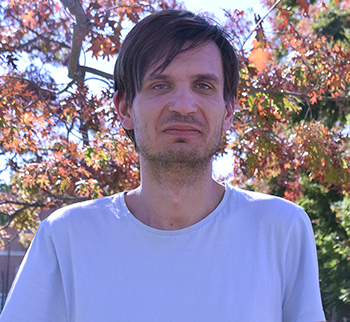
Jan Lanicek
The reaches of the USC Shoah Foundation’s Visual History Archive are unparalleled, attracting researchers and professors from such places as Sydney, Australia and enabling them to further their work with the testimonies available online.
Jan Lanicek, lecturer in Jewish history and Modern European history at the University of New South Wales in Sydney, has worked with what’s been available to him from the collection for a long time. In the States for a conference this week, he took the opportunity to visit USC Shoah Foundation in Leavey Library at USC and comb through its reserves for testimony relevant to his work.
“I’m a Holocaust historian,” Lanicek said. “It’s common knowledge among historians of the Holocaust that this collection exists and that we can use it in our teaching and our research as well.”
Lanicek’s own research spans two topics - the death marches and death trains crossing Czechoslovakia in the spring of 1945, and Czech police forces in the Theresienstadt ghetto. For the latter, he’s tried to rely more on eyewitness testimony to tell necessary stories.
“I’ve been able to find a lot of primary sources like documents and printed reports of testimonies,” Lanicek said. “I thought it would be useful to have a look also if there’s anything specific in the oral testimonies, which I could use for my project.”
His research analyzes testimony of how police forces in the ghetto and other similar places in the protectorate behaved toward prisoners during the war.
“I’ve mostly been studying this because of the postwar retribution.” Lanicek said. “Some of [the police] were put on trial because they were brutal or because they stole stuff from prisoners. I wanted to see how they are represented in the memory of survivors.”
For Lanicek, the value of survivor testimony, and by extension the value of the Visual History Archive, lies in its ability to bring a human dimension to stories and history typically found on paper. As a professor attempting to reach students from both in- and outside the historical faculty, he seeks to forge genuine interest in the subject by providing his students with real testimonies.
“There is quite a large survivor community in Sydney,” Lanicek said. “Always when I teach a course on the Holocaust, I have one friend who is 86 now and he always comes to the class and spends two hours talking to my students.”
But because his friend cannot make every class, Lanicek finds immense value in the recorded testimonies provided by the Visual History Archive, in their ability to help students move beyond printed books and articles and reach the human dimension in all of the stories he’s attempting to teach.
While Lanicek is hesitant to use exclusively testimony as a source in his research and teaching because he’s still learning the methodology of working with testimonies, he still believes it’s invaluable to include.
The historian hopes his research helps spark discussion about the Holocaust in the Czech Republic, where he feels the acknowledgement of criminal action hasn’t been enough. Of course, he says, all historians want to be read and heard, but more than that, they want to commemorate how people lived and remember how they suffered.
“In the case of Czech society, they still wait for proper discussion about how ordinary Czechs behaved during the war towards the Jews,” Lanicek said. “Nowadays, discussion is about Poland and Ukraine and how the memory of the Holocaust is under threat because of the political changes - but in the Czech Republic, there hasn’t been any discussion yet. So hopefully my research and the research of my colleagues would eventually lead to some deeper discussion about Czech society during the war and their attitude toward the Jews. That is the big hope.”